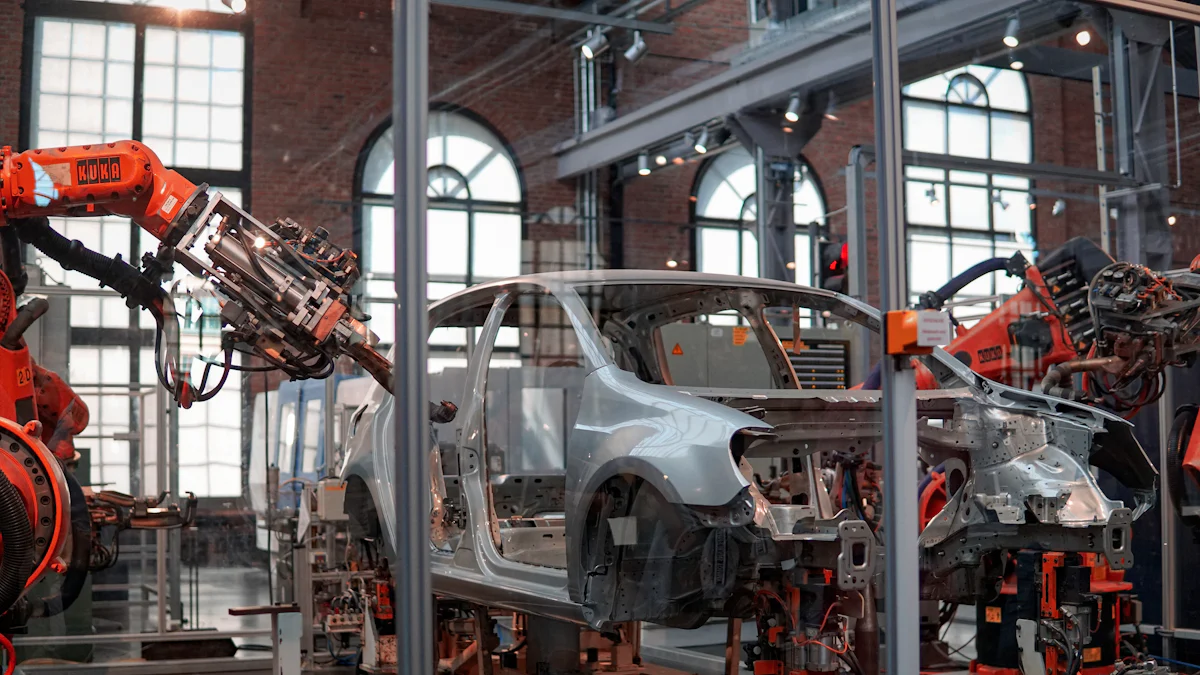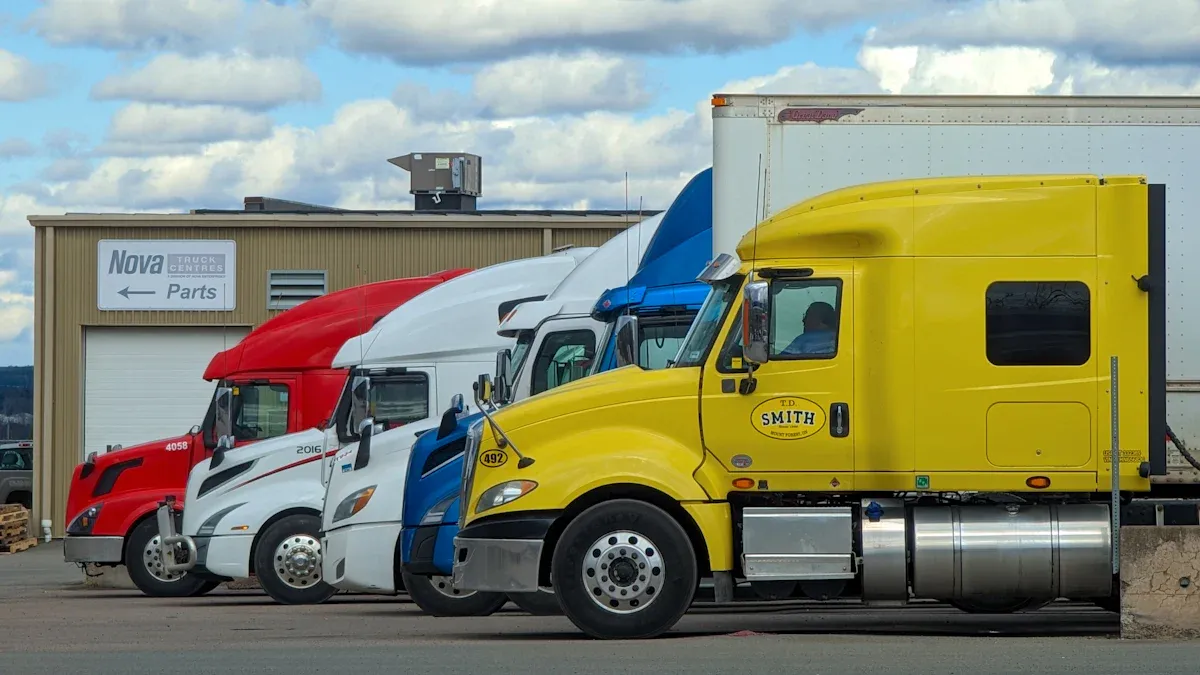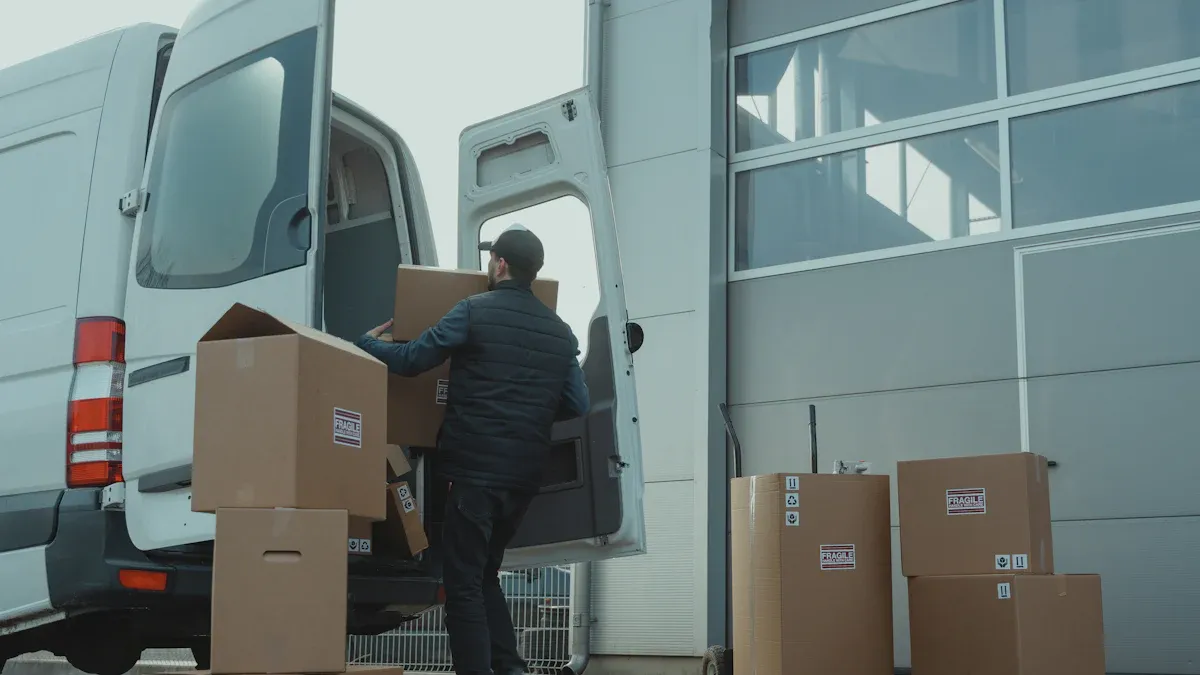Transporting Auto Parts from China to Europe

When you look for the best way of transporting auto parts from China to Europe, you need to think about speed, cost, and safety. Air freight gives you fast delivery in just a few days, but it costs more and works best for urgent or high-value parts. Sea freight helps you save money when you ship large loads, though it takes longer. You must pack fragile items well to keep them safe. JUSDA’s China-Europe Express Rail offers a smart balance between speed and cost for many shipments.
Key Takeaways
Choose air freight for urgent shipments. It offers fast delivery in 1 to 10 days, ideal for high-value parts.
Select sea freight for large, non-urgent shipments. It is the most cost-effective option, though delivery takes 20 to 60 days.
Consider rail freight with JUSDA for a balance of speed and cost. It delivers in 10 to 30 days and is cheaper than air freight.
Pack auto parts carefully to prevent damage. Use strong materials like wooden crates and foam inserts for fragile items.
Stay organized with documentation. Prepare all necessary papers to avoid delays and ensure smooth customs clearance.
Transporting Auto Parts: Key Methods

Air Freight
Air freight gives you the fastest way to move auto parts from China to Europe. You can expect delivery in less than a week. This method works best when you need urgent shipments or high-value items. Many manufacturers use air freight to avoid costly downtime. For example, a company shipped two tonnes of auto parts from China to Spain in just 36 hours to keep production running.
You often ship engines, windshields, and other critical components by air. These parts need to arrive quickly to support just-in-time production. Air freight also handles a wide range of auto parts, from small screws to large engines.
Here is a quick look at the main advantages and disadvantages:
Advantages | Disadvantages |
|---|---|
Speedy deliveries | Higher costs compared to other methods |
Lower insurance premiums | Size limitations for cargo |
Efficient and secure transport | Risk of substantial loss due to glitches |
Value for money for timely delivery | Environmental concerns due to CO2 emissions |
You pay more for air freight. The cost per kilogram ranges from $4 to $9, depending on the route. For example, shipping from Beijing to Warsaw costs $4–$8 per kilogram. Transit times are short:
Route | Transit Time |
|---|---|
China → Germany (Frankfurt/Munich) | 5–7 days |
China → France (Paris) | 6–8 days |
China → Spain (Madrid/Barcelona) | 6–9 days |
China → Netherlands (Amsterdam) | 5–8 days |
Tip: Use air freight for urgent, high-value, or fragile auto parts that cannot wait.
Sea Freight
Sea freight is the most cost-effective way for transporting auto parts in large volumes. You choose this method when you ship heavy or bulky items and do not need fast delivery. Sea freight suits engines, transmissions, axles, and other large components. You can also ship medium-sized parts like brakes and alternators on pallets. Fragile items such as windshields and headlights need custom packaging.
Here is a breakdown of which parts fit each shipping method:
Size Category | Examples | Shipping Method |
|---|---|---|
Small Parts | Screws, gaskets, filters | Parcel services |
Medium-Sized Parts | Brakes, clutches, alternators | Pallet shipping |
Large Parts | Engines, transmissions, axles | Freight services |
Fragile Parts | Windshields, headlights | Custom packaging solutions |
You save money with sea freight. The average cost for a 20ft container is $1,800–$2,800. A 40ft container costs $2,800–$4,500. Transit times are longer:
Port of Loading | Port of Destination | Transit Time |
|---|---|---|
Shanghai | Budapest | 37 days |
Shenzhen | Budapest | 30 days |
Qingdao | Budapest | 45 days |
Note: Sea freight works best for large shipments and non-urgent deliveries. Always pack fragile parts carefully.
Rail Freight with JUSDA
Rail freight, especially JUSDA’s China-Europe Express Rail, gives you a smart balance between speed and cost. You get your auto parts delivered in 10 to 20 days, much faster than sea freight and much cheaper than air freight. Many European industries rely on this method for stable supply chains.
Rail freight is ideal for large, high-value cargo like engines and aftermarket suspension components. You also ship other mechanical equipment this way. The automotive sector uses rail freight to keep production efficient and avoid delays.
Type of Auto Part | Reason for Shipping |
|---|---|
Aftermarket suspension components | High-value and time-sensitive |
Engines | High-value and time-sensitive |
Other mechanical equipment | High-value and time-sensitive |
You pay about $7,000–$10,000 per 40ft container for rail freight. This cost is about one-fifth of air freight and much less than shipping by plane. Rail freight volumes increased by 120% in 2024, showing that more companies choose this method.
Average transit times for rail routes:
Route | Average Transit Time |
|---|---|
Chengdu to Duisburg | 12-14 days |
Xi’an to Hamburg | 14-16 days |
Wuhan to London | 15-18 days |
Yiwu to Madrid | 16-20 days |
Nanchang to Warsaw | 14-16 days |
🚄 JUSDA’s China-Europe Express Rail helps you transport auto parts quickly and affordably. You get reliable service and smooth customs operations.
When you compare all three methods for transporting auto parts, you see that air freight is best for urgent and high-value shipments, sea freight is best for large and non-urgent loads, and rail freight with JUSDA gives you a balanced solution for speed and cost. Choose the method that fits your needs and budget.
Packing Auto Parts

Engines and Heavy Items
You need strong packing methods for engines and other heavy auto parts. Use wooden pallets to keep parts secure. Foam inserts and bubble wrap protect fragile components. Place engines in wooden crates or reinforced cardboard boxes. Anti-corrosion wraps stop moisture and rust. Double-boxing adds extra protection for sensitive items. Impact indicators help you monitor rough handling. Clear labeling tells carriers to handle fragile items with care.
Packing Material/Method | Description |
|---|---|
Wooden pallets | Secure heavy parts like engines and transmissions. |
Foam inserts, bubble wrap, corrugated boxes | Protect fragile components during shipping. |
Wooden crates or reinforced cardboard | Ideal for heavy or bulky auto parts. |
Anti-corrosion wraps | Prevent moisture and rust on metal parts. |
Double-boxing | Adds extra protection for sensitive items. |
Impact indicators | Monitor rough handling during transit. |
Clear labeling | Alerts carriers to handle fragile items with care. |
Drain all liquids from engines before shipping. This prevents leaks and protects the packaging. Always inspect shipments for damage before the driver leaves. Poor packaging can cause damage and lead to delays or lost customers.
JUSDA uses advanced packing solutions to keep your heavy auto parts safe and compliant.
Body Panels and Bumpers
You must protect body panels and bumpers from scratches and dents. Use plastic wrappings, covers, and protective tape. Reusable steel shipping racks keep large parts safe and maximize storage. These racks protect sensitive surfaces. Always check packaging before shipping. For high-value orders, use Container Loading Supervision to ensure careful handling.
Use plastic wrappings, covers, and protective tape.
Check packaging before shipping.
JUSDA’s team follows strict procedures to prevent damage during transit.
Tyres and Rubber Components
You should pack tyres and rubber parts to avoid deformation. Stack tyres upright and secure them with straps. Use clean, dry containers to prevent moisture damage. For rubber components, wrap each item in protective film. Label packages clearly to help with handling and customs checks.
Compliance and Safety
You must follow international standards when packing auto parts for export. Check if your parts need China CCC Certification or EU E-mark Certification. Reinforce fragile items with EPE foam and wooden crates. Label outer packaging as 'Fragile'. Learn about special certification standards for unique automotive accessories.
Standard | Requirement |
|---|---|
China CCC Certification | Mandatory for safety-related vehicle structural components; check if included in the catalog. |
EU E-mark Certification | Required for lighting fixtures and accessories; certification cycle lasts 4-6 weeks. |
Loss Prevention Requirements | Fragile items must be reinforced with EPE foam and wooden crates; outer packaging must be labeled 'Fragile'. |
Product Compliance and Certification | Familiarize with specific certification standards for special automotive accessories. |
JUSDA’s expertise helps you meet all compliance and safety standards when Transporting Auto Parts from China to Europe.
Transit Times and Costs
Air Freight Times
You get the fastest delivery when you choose air freight for transporting auto parts from China to Europe. Most shipments arrive in 1 to 10 days. For example, if you ship from China to Germany, your parts often arrive in 3 to 7 days. Air freight works best when you need parts quickly to avoid delays in production.
Sea Freight Times
Sea freight takes longer, but it is a good choice for large shipments. You can expect your auto parts to arrive in 20 to 60 days. The exact time depends on the ports and the shipping route. If you do not need your parts right away, sea freight helps you save money.
Rail Freight Times (China-Europe Express Rail)
Rail freight, especially with JUSDA’s China-Europe Express Rail, gives you a middle option. Your auto parts usually arrive in 10 to 30 days. Most shipments take about 15 to 20 days door-to-door. This method is faster than sea freight and costs less than air freight. Many companies use rail freight to keep their supply chains steady.
🚄 Rail freight offers a smart balance between speed and cost for transporting auto parts.
Here is a quick comparison of transit times:
Freight Mode | Estimated Transit Time |
|---|---|
Air Freight | 1–10 days |
Rail Freight | 10–30 days |
Sea Freight | 20–60 days |
Cost Comparison
You need to think about both speed and cost when choosing a shipping method. Air freight costs the most, but you get fast delivery. Rail freight costs less and still gives you quick service. Sea freight is the cheapest for large shipments, but it takes the longest.
Shipping Method | Cost per Kilogram | Average Cost for Large Shipments |
|---|---|---|
Air Freight | $4 to $9 | $5.20 (for shipments over 500kg) |
Rail Freight | $2.30 to $3.00 | $2.56 (from Chengdu to Duisburg) |
Sea Freight | N/A | $2,250 for a 20' container |
If you want to save money and still get your auto parts on time, rail freight with JUSDA is a great choice. You get reliable service and a good balance between cost and speed.
Supply Chain Solutions by JUSDA
JusLink Intelligent Platform
You can manage your entire supply chain with JUSDA’s JusLink Intelligent Platform. JusLink uses IoT, cloud computing, and big data to give you real-time updates. You see where your auto parts are at every step. You track shipments, check inventory, and get alerts if something changes. JusLink helps you make quick decisions. You avoid delays and keep your business running smoothly.
JusLink makes your supply chain transparent. You know exactly when your auto parts will arrive.
Many manufacturers use JusLink to connect their teams. You share information with suppliers and customers. You solve problems faster. JusLink helps you save time and money.
Customs and Documentation
You need to clear customs quickly when shipping auto parts from China to Europe. JUSDA’s team helps you prepare all the documents you need. You get support for customs declarations, certificates, and compliance checks. JUSDA knows the rules for each country. You avoid mistakes and reduce the risk of delays.
Here is what JUSDA helps you with:
Customs declarations
Import and export certificates
Compliance with EU and China regulations
Tracking customs status
JUSDA’s experts guide you through every step. You ship your auto parts without worry.
Inventory and Warehousing
You keep your auto parts safe with JUSDA’s cloud warehousing solutions. You store parts in secure warehouses across China and Europe. You check your inventory online at any time. JUSDA uses smart technology to track every item. You get alerts when stock runs low.
Service | Benefit |
|---|---|
Cloud Warehousing | Real-time inventory tracking |
Smart Warehousing | Automated stock management |
Global Network | Warehouses in key locations |
JUSDA’s customer stories show how smart warehousing reduces costs and improves delivery times. One manufacturer used JUSDA’s platform to cut inventory costs and speed up shipments to Europe.
You choose JUSDA to make your supply chain simple, fast, and reliable.
Practical Tips for Shipping
Cost-Saving Strategies
You can lower your shipping costs by making smart choices. Many companies save money by switching transportation modes. For example, a China-based auto parts company reduced costs by 10% and cut transit time by 45 days when they chose rail instead of ocean shipping. You should explore different options to find the best fit for your needs.
Try buyers consolidation loads. This method lets you combine shipments from multiple suppliers, which helps you fill containers and save on shipping fees.
Select ports with lower fees and handling charges. You can reduce extra costs by choosing the right port for your shipment.
Tip: Always compare transportation modes and routes before booking. You may find a faster and cheaper solution.
Avoiding Common Pitfalls
Shipping auto parts internationally can be tricky. You need to prepare all documents carefully to avoid delays and extra charges. Make sure you have packing lists, commercial invoices, custom bonds, and a Bill of Lading. You also need certificates of origin and insurance. If you ship hazardous parts, include a Material Safety Data Sheet.
Common Documentation Errors | Implications |
|---|---|
Delays and wrong duties | |
Incomplete Commercial Invoices | Customs rejection |
Inconsistent Information | Confusion at customs |
Missing Certificates | Missed required certifications |
You should learn import and export laws. Ignoring restricted items or missing paperwork can lead to penalties or shipment delays.
Choosing Reliable Partners
You need a trusted logistics partner to ship auto parts smoothly. Look for companies with experience in international shipments and strong industry knowledge. Check if they have a global network and advanced tracking systems. Reliable partners like JUSDA offer real-time shipment visibility and help you clear customs quickly.
Criteria | Description |
|---|---|
Experience and Expertise | Proven track record in auto parts shipping |
Global Network | Warehouses and hubs in key locations |
Customs Clearance Expertise | Knowledge of European procedures |
Technology and Innovation | Real-time tracking and data analytics |
Reliability and Responsiveness | On-time deliveries and strong support |
Note: Define your business needs and check credentials before choosing a logistics partner. Good communication and flexible services make shipping easier.
You improve your auto parts shipping by choosing the right method and partner. Air, sea, and rail each offer unique advantages. JUSDA helps you manage every step with smart technology and expert support. You benefit from innovations like AI product selection and blockchain tracking. Review these key areas for success:
Key Area | Insights |
|---|---|
Order Processing | Use EDI systems for real-time monitoring and optimize trade terms. |
Transportation | Select air, sea, or rail based on value, cost, and speed. |
Customs Clearance | Obtain certificates and use AEO for smooth customs. |
Warehouse Management | Apply intelligent systems for inventory planning. |
Last-mile Delivery | Integrate advanced networks for efficient service. |
JUSDA’s solutions make your supply chain efficient and reliable. You can consult JUSDA for tailored logistics services.
FAQ
How do you choose the best shipping method for auto parts?
You should look at your budget, delivery time, and the size of your shipment. Air freight works best for urgent needs. Sea freight fits large, non-urgent loads. Rail freight gives you a balance between speed and cost.
What documents do you need to ship auto parts from China to Europe?
You need a commercial invoice, packing list, Bill of Lading, and certificates of origin. Customs may also ask for product compliance certificates. JUSDA helps you prepare all documents for smooth customs clearance.
How can you make sure your auto parts arrive safely?
Pack each part with strong materials. Use foam, crates, or racks for protection. Label fragile items clearly. JUSDA uses advanced packing methods to keep your parts safe during transport.
What is the average transit time for rail freight?
Rail freight with JUSDA’s China-Europe Express Rail usually takes 15 to 20 days door-to-door. This option is faster than sea freight and more affordable than air freight.
Can you track your shipment in real time?
Yes, you can. JUSDA’s JusLink platform lets you track your shipment at every step. You get real-time updates and alerts, so you always know where your auto parts are.
See Also
Expert Strategies for Overcoming Automotive Supply Chain Hurdles
Addressing Global Supply Chain Growth Issues Effectively
Maximizing Efficiency in Your Automotive Supply Chain
Mastering Lean Logistics for Advanced Manufacturing Achievements
Transforming Future Logistics with AI Supply Chain Innovations
